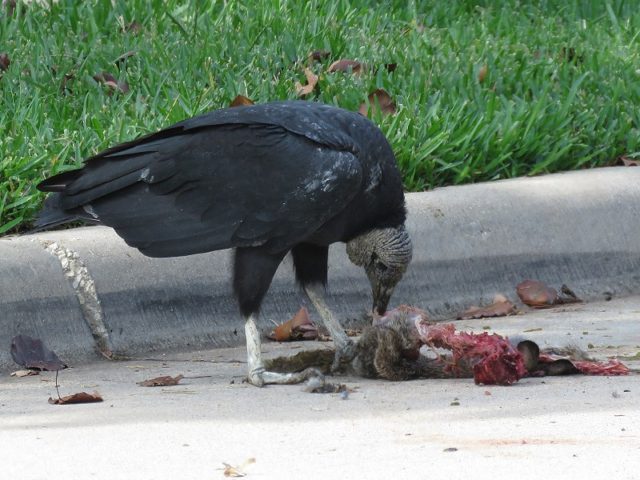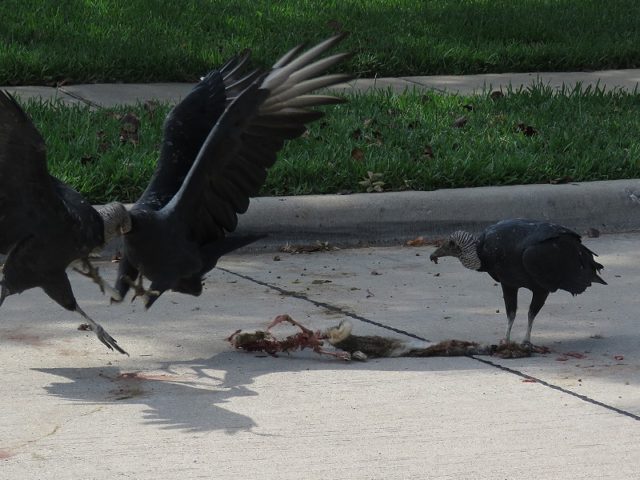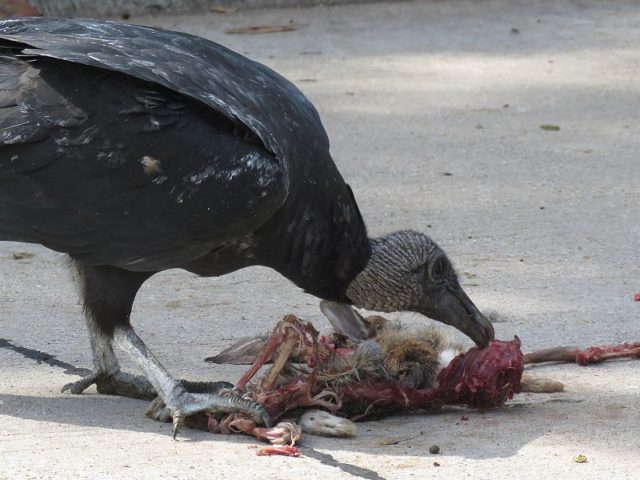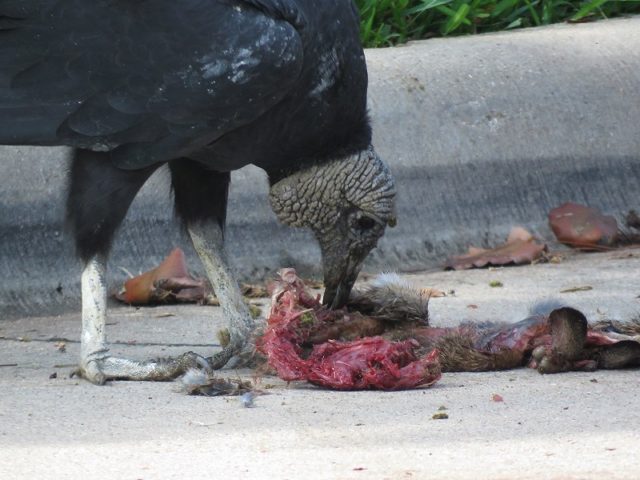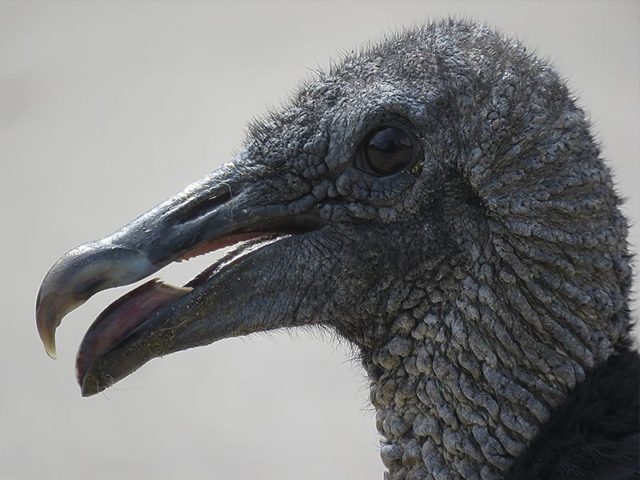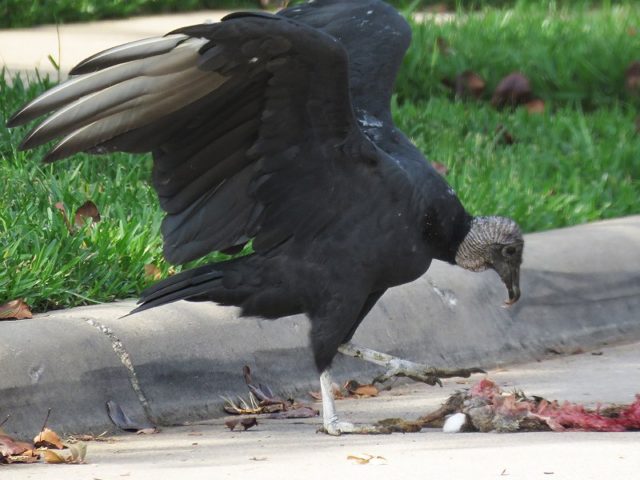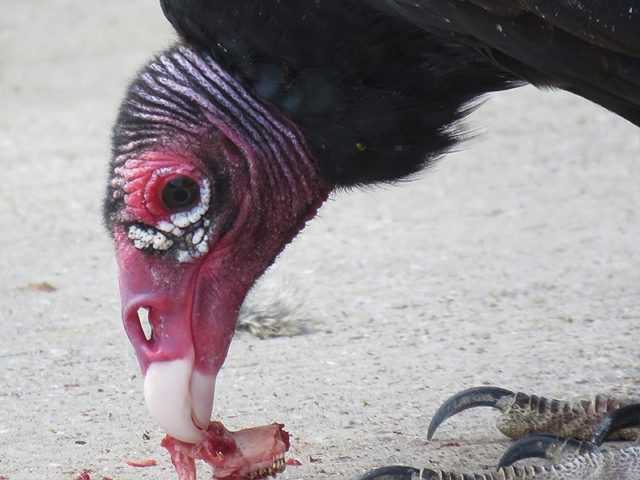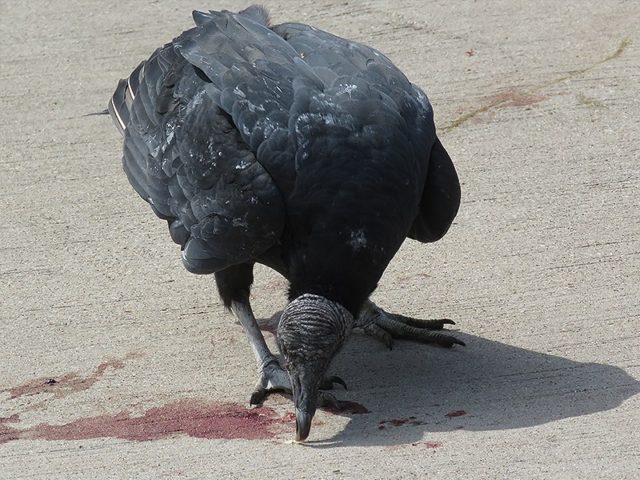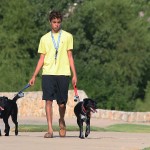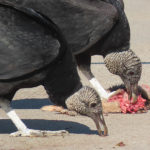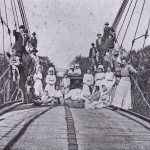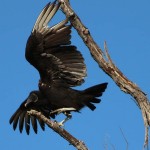We have two species of vultures here in North Texas–the Black Vulture and the Turkey Vulture. These carrion eating birds are not afraid to enter our subdivisions in search of a roadkill meal. Even the death of a single Eastern Cottontail can bring dozens of these bird in to feed.
Turkey Vultures–distinguished by their pink heads and ivory bills–are attracted to deceased animals by smell. They are often the first vultures on site.
The more gregarious Black Vulture relies on sight. When a group of these vultures spies Turkey Vultures on a meal, they don’t hesitate to join in. Often a group of rowdy Black Vultures will succeed in driving the Turkey Vultures away in short order.
Other times, when the picking are lean, the Turkey Vultures will do their best to stick around for their fair share of the meal. That was the case with this neighborhood roadkill find. A small cottontail rabbit was on the menu. There was not much room around the table…




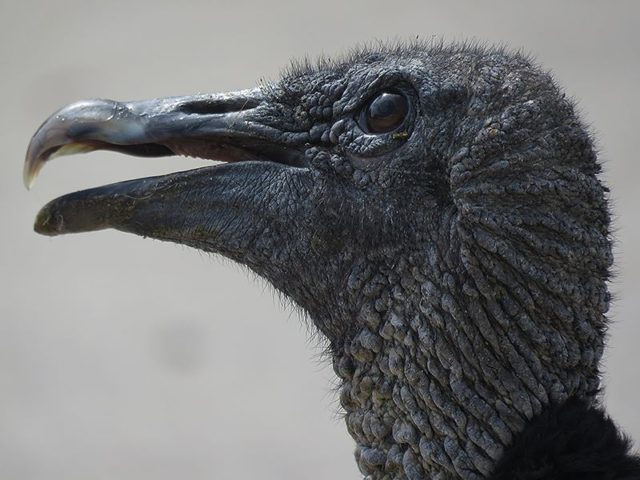

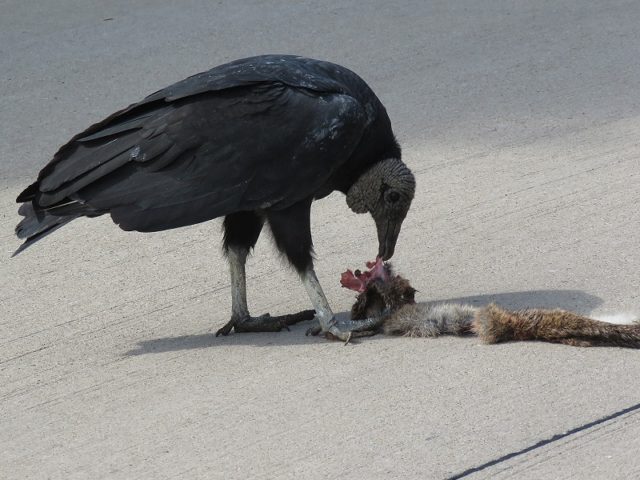
Wikipedia reports the following concerning Black Vultures…
The black vulture is a fairly large bird of prey, measuring 56–74 cm (22–29 in) in length, with a 1.33–1.67 m (52–66 in) wingspan. Weight for black vultures from North America and the Andes ranges from 1.6 to 3 kg (3.5 to 6.6 lb) but in the smaller vultures of the tropical lowlands it is 1.18–1.94 kg (2.6–4.3 lb). 50 vultures in Texas were found to average 2.15 kg (4.7 lb) while 119 birds in Venezuela were found to average 1.64 kg (3.6 lb). The extended wing bone measures 38.6–45 cm (15.2–17.7 in), the shortish tail measures 16–21 cm (6.3–8.3 in) and the relatively long tarsus measures 7–8.5 cm (2.8–3.3 in). Its plumage is mainly glossy black. The head and neck are featherless and the skin is dark gray and wrinkled. The iris of the eye is brown and has a single incomplete row of eyelashes on the upper lid and two rows on the lower lid. The legs are grayish white, while the two front toes of the foot are long and have small webs at their bases. The feet are flat, relatively weak, and are poorly adapted to grasping; the talons are also not designed for grasping, as they are relatively blunt.
The nostrils are not divided by a septum, but rather are perforate; from the side one can see through the beak. The wings are broad but relatively short. The bases of the primary feathers are white, producing a white patch on the underside of the wing’s edge, which is visible in flight. The tail is short and square, barely reaching past the edge of the folded wings. The subspecies differ in size according to Bergmann’s rule, and the amount of white underwing coloration also varies.
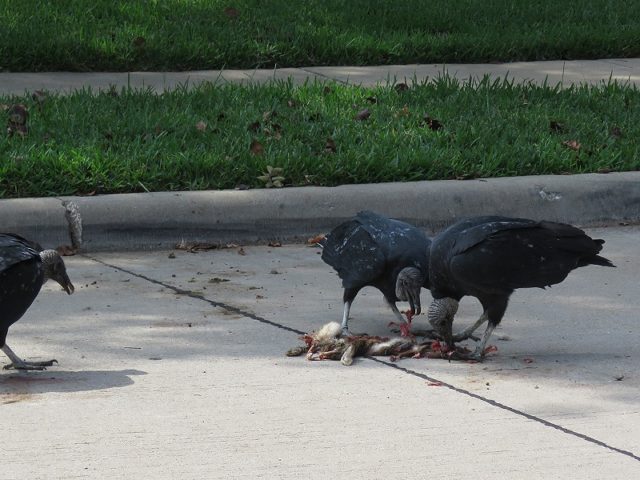


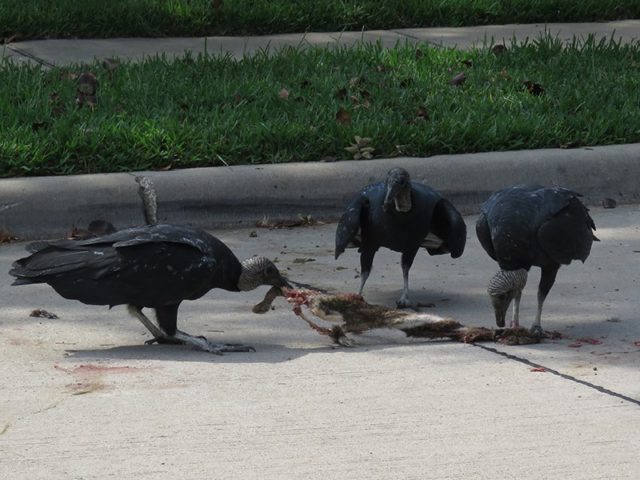
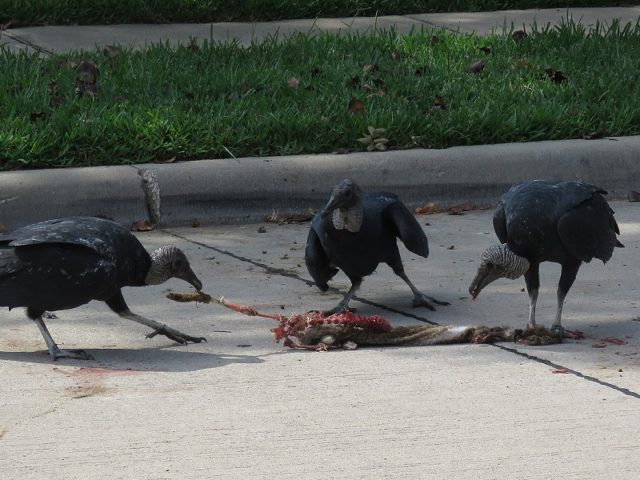
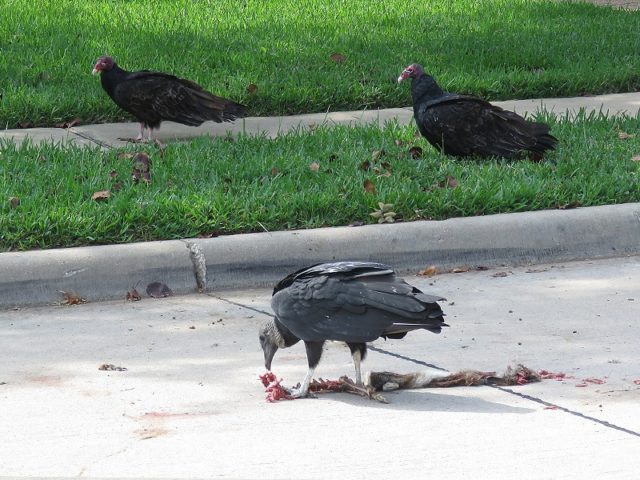
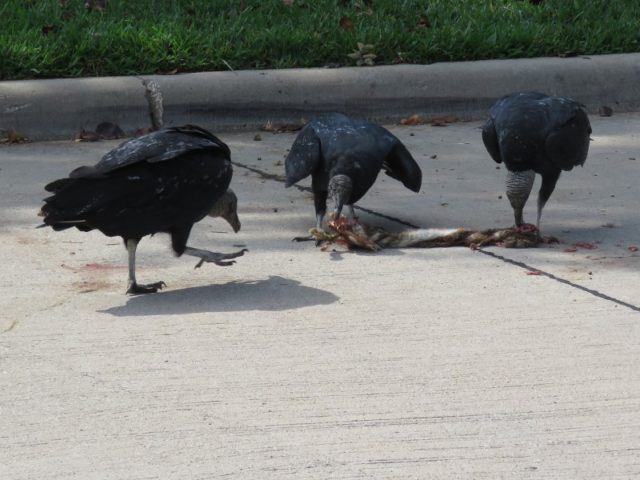
The black vulture soars high while searching for food, holding its wings horizontally when gliding. It flaps in short bursts which are followed by short periods of gliding. Its flight is less efficient than that of other vultures, as the wings are not as long, forming a smaller wing area. In comparison with the turkey vulture, the black vulture flaps its wings more frequently during flight. It is known to regurgitate when approached or disturbed, which assists in predator deterrence and taking flight by decreasing its takeoff weight. Like all New World vultures, the black vulture often defecates on its own legs, using the evaporation of the water in the feces and/or urine to cool itself, a process known as urohidrosis. It cools the blood vessels in the unfeathered tarsi and feet, and causes white uric acid to streak the legs. Because it lacks a syrinx, the black vulture, like other New World vultures, has very few vocalization capabilities. It is generally silent, but can make hisses and grunts when agitated or while feeding. The black vulture is gregarious, and roosts in large groups. In areas where their ranges overlap, the black vulture will roost on the bare branches of dead trees alongside groups of turkey vultures. The black vulture generally forages in groups; a flock of black vultures can easily drive a rival turkey vulture, which is generally solitary while foraging, from a carcass.
Like the turkey vulture, this vulture is often seen standing in a spread-winged stance. The stance is believed to serve multiple functions: drying the wings, warming the body, and baking off bacteria. This same behavior is displayed by other New World vultures, Old World vultures, and storks.

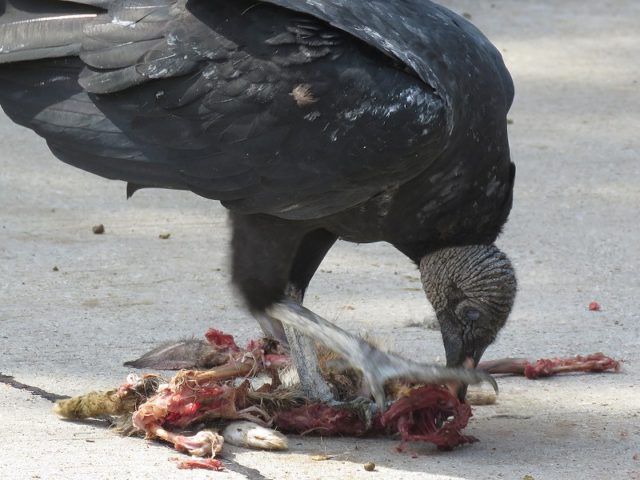
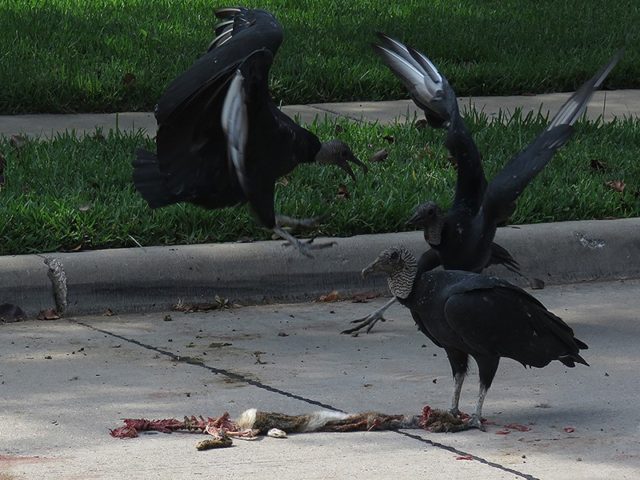
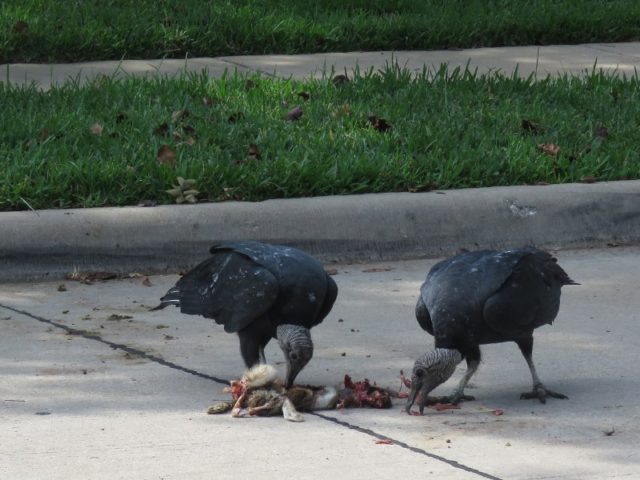

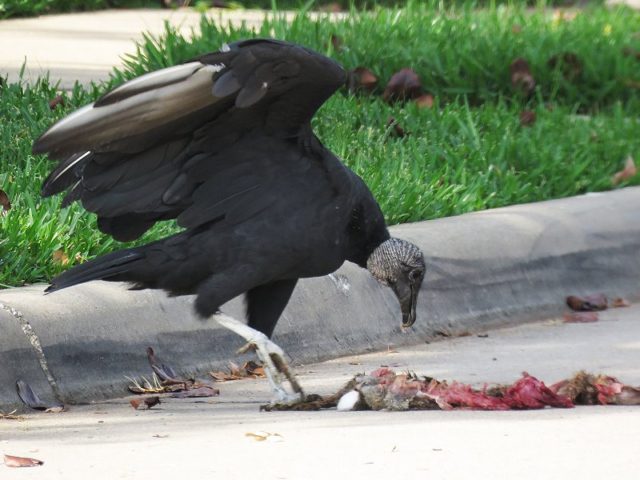
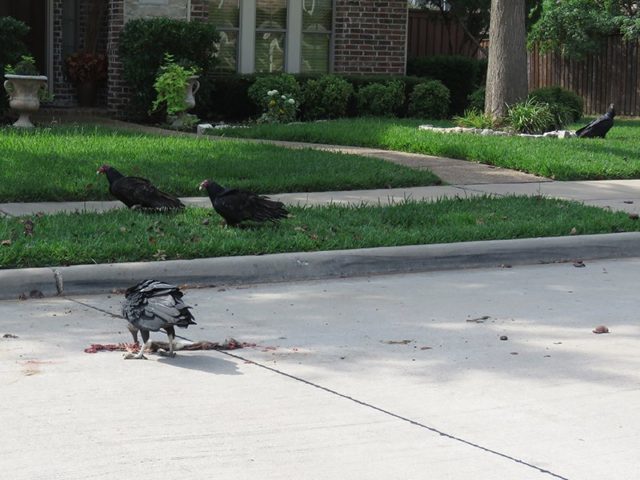
In natural settings, the black vulture eats mainly carrion. In areas populated by humans, it may scavenge at garbage dumps, but also takes eggs and decomposing plant material and can kill or injure newborn or incapacitated mammals. Like other vultures, it plays an important role in the ecosystem by disposing of carrion which would otherwise be a breeding ground for disease. The black vulture locates food either by sight or by following New World vultures of the genus Cathartes to carcasses. These vultures—the turkey vulture, the lesser yellow-headed vulture, and the greater yellow-headed vulture—forage by detecting the scent of ethyl mercaptan, a gas produced by the beginnings of decay in dead animals. Their heightened ability to detect odors allows them to search for carrion below the forest canopy. The black vulture is aggressive when feeding, and may chase the slightly larger turkey vulture from carcasses.
The black vulture also occasionally feeds on livestock or deer. It is the only species of New World vulture which preys on cattle. It occasionally harasses cows which are giving birth, but primarily preys on newborn calves. In its first few weeks, a calf will allow vultures to approach it. The vultures swarm the calf in a group, then peck at the calf’s eyes, or at the nose or the tongue. The calf then goes into shock and is killed by the vultures. Black vultures have sometimes been seen to pick ticks off resting capybaras.
Like other birds with scavenging habits, the black vulture presents resistance to pathogenic microorganisms and their toxins. Many mechanisms may explain this resistance. Anti-microbial agents may be secreted by the liver or gastric epithelium, or produced by microorganisms of the normal microbiota of the species.

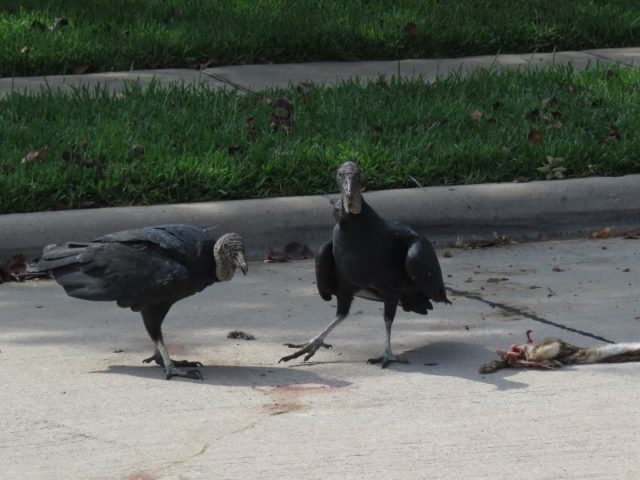
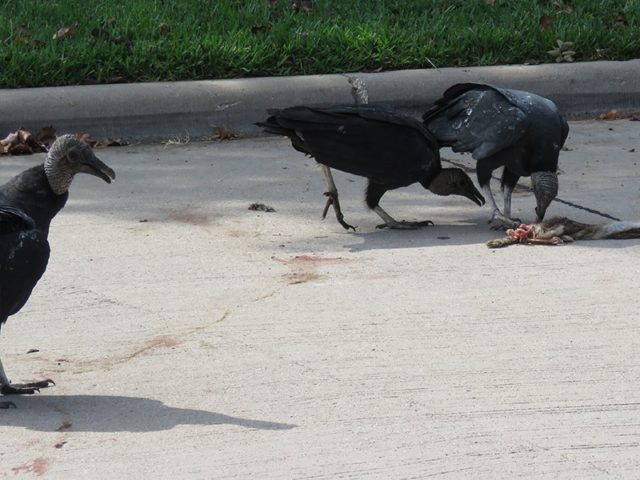
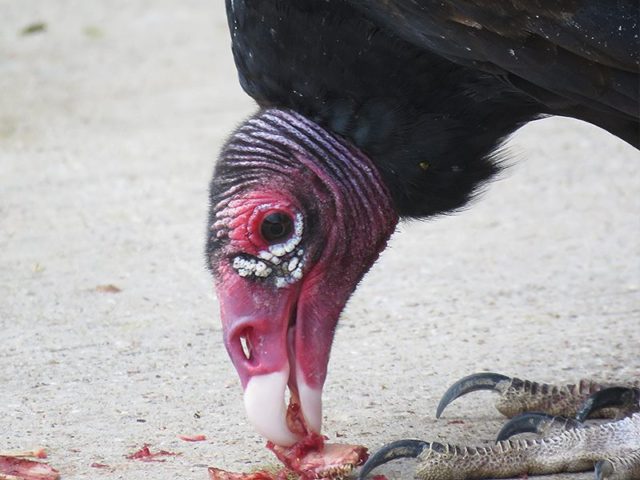
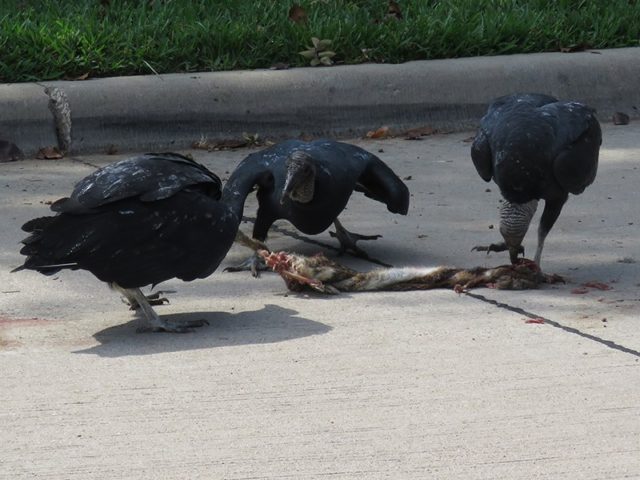
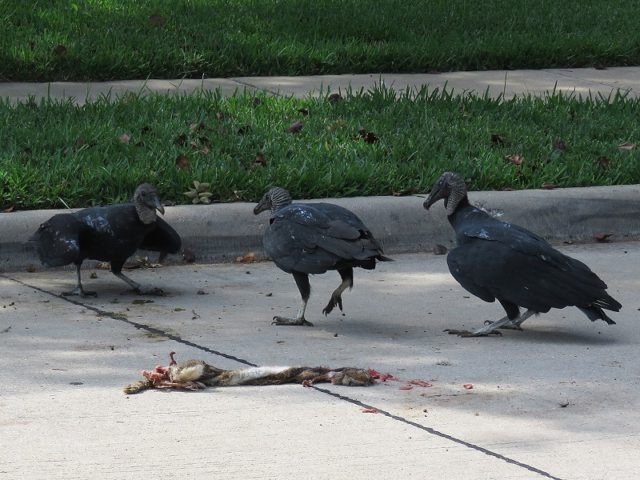
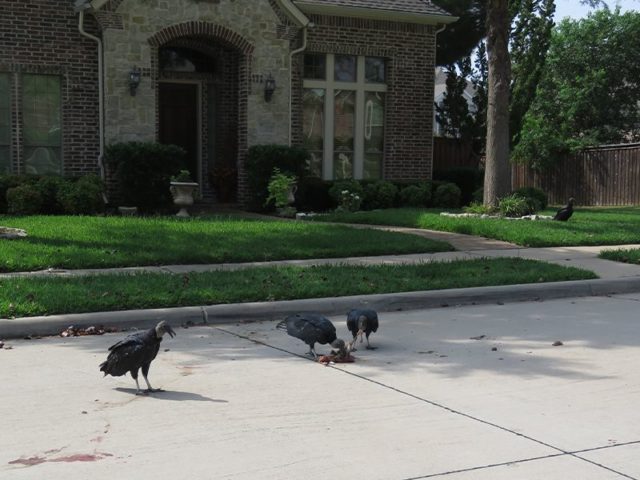
Wikipedia describes the Turkey Vulture in this way…
A large bird, it has a wingspan of 160–183 cm (63–72 in), a length of 62–81 cm (24–32 in), and weight of 0.8 to 2.41 kg (1.8 to 5.3 lb). Birds in the northern limit of the species’ range average larger in size than the vulture from the neotropics. 124 birds from Florida averaged 2 kg (4.4 lb) while 65 and 130 birds from Venezuela were found to average 1.22 and 1.45 kg (2.7 and 3.2 lb), respectively. It displays minimal sexual dimorphism; sexes are identical in plumage and in coloration, and are similar in size. The body feathers are mostly brownish-black, but the flight feathers on the wings appear to be silvery-gray beneath, contrasting with the darker wing linings. The adult’s head is small in proportion to its body and is red in color with few to no feathers. It also has a relatively short, hooked, ivory-colored beak. The irises of the eyes are gray-brown; legs and feet are pink-skinned, although typically stained white. The eye has a single incomplete row of eyelashes on the upper lid and two rows on the lower lid.
The two front toes of the foot are long and have small webs at their bases. Tracks are large, between 9.5 and 14 cm (3.7 and 5.5 in) in length and 8.2 and 10.2 cm (3.2 and 4.0 in) in width, both measurements including claw marks. Toes are arranged in the classic, anisodactyl pattern. The feet are flat, relatively weak, and poorly adapted to grasping; the talons are also not designed for grasping, as they are relatively blunt. In flight, the tail is long and slim. The black vulture is relatively shorter-tailed and shorter-winged, which makes it appear rather smaller in flight than the turkey vulture, although the body masses of the two species are roughly the same. The nostrils are not divided by a septum, but rather are perforate; from the side one can see through the beak. It undergoes a molt in late winter to early spring. It is a gradual molt, which lasts until early autumn. The immature bird has a gray head with a black beak tip; the colors change to those of the adult as the bird matures. Captive longevity is not well known. As of 2015 there are two captive birds over 40 years old: the Gabbert Raptor Center on the University of Minnesota campus is home to a turkey vulture named Nero with a confirmed hatch year of 1974, and another male bird, named Richard, lives at the Lindsay Wildlife Experience in Walnut Creek, CA. Richard hatched in 1974 and arrived at the museum later that year. The oldest wild captured banded bird was 16 years old.
The turkey vulture, like most other vultures, has very few vocalization capabilities. Because it lacks a syrinx, it can only utter hisses and grunts. It usually hisses when it feels threatened, or when fighting with other vultures over a carcass. Grunts are commonly heard from hungry young and from adults in their courtship display.
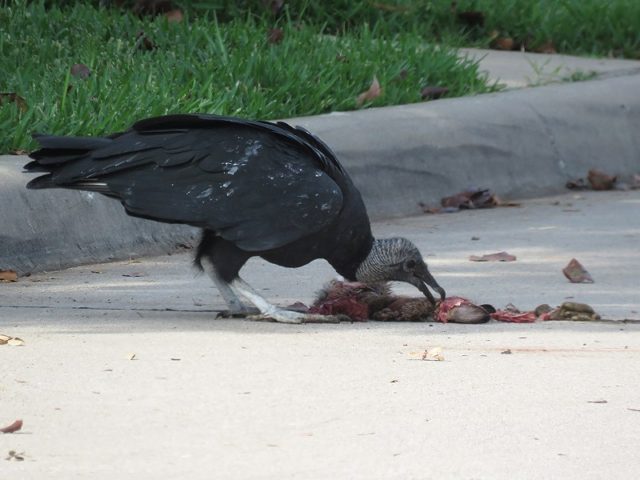
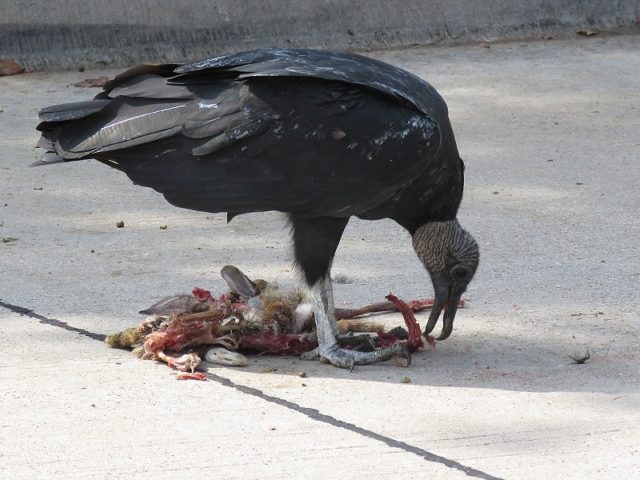
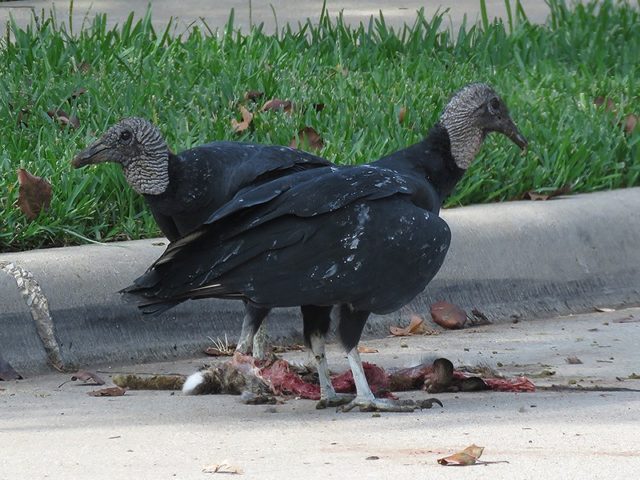
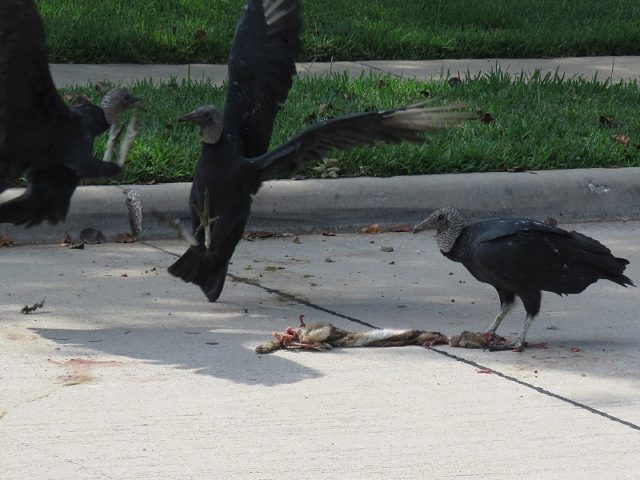
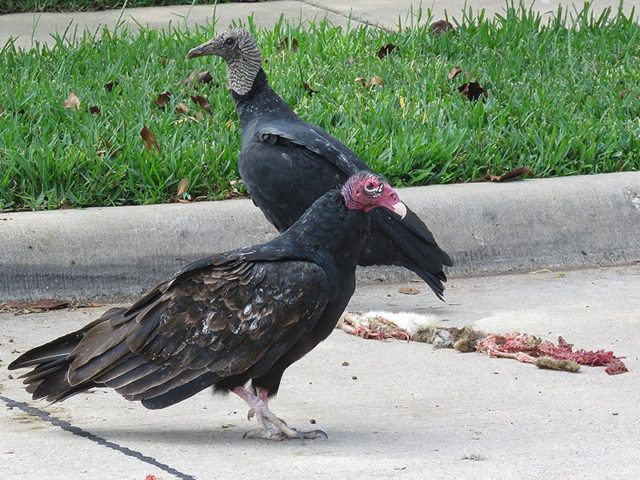
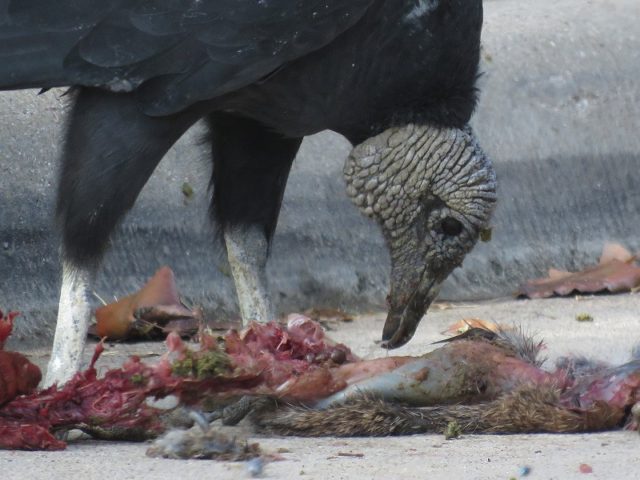

The turkey vulture is gregarious and roosts in large community groups, breaking away to forage independently during the day. Several hundred vultures may roost communally in groups, which sometimes even include black vultures. It roosts on dead, leafless trees, and will also roost on man-made structures such as water or microwave towers. Though it nests in caves, it does not enter them except during the breeding season. The turkey vulture lowers its night-time body temperature by about 6 degrees Celsius to 34 °C (93 °F), becoming slightly hypothermic.
This vulture is often seen standing in a spread-winged stance. The stance is believed to serve multiple functions: drying the wings, warming the body, and baking off bacteria. It is practiced more often following damp or rainy nights. This same behavior is displayed by other New World vultures, by Old World vultures, and by storks. Like storks, the turkey vulture often defecates on its own legs, using the evaporation of the water in the feces and/or urine to cool itself, a process known as urohidrosis. It cools the blood vessels in the unfeathered tarsi and feet, and causes white uric acid to streak the legs. The turkey vulture has few natural predators. Adult, immature and fledging vultures may fall prey to great horned owls, red-tailed hawks, golden eagles and bald eagles, while eggs and nestlings may be preyed on by mammals such as raccoons and opossums. Foxes can occasionally ambush an adult but species that can climb are more likely to breach and predate nests than adults. Its primary form of defense is regurgitating semi-digested meat, a foul-smelling substance, which deters most creatures intent on raiding a vulture nest. It will also sting if the predator is close enough to get the vomit in its face or eyes. In some cases, the vulture must rid its crop of a heavy, undigested meal to take flight to flee from a potential predator. Its life expectancy in the wild ranges upward of 16 years, with a captive life span of over 30 years being possible.
The turkey vulture is awkward on the ground with an ungainly, hopping walk. It requires a great deal of effort to take flight, flapping its wings while pushing off the ground and hopping with its feet. While soaring, the turkey vulture holds its wings in a shallow V-shape and often tips from side to side, frequently causing the gray flight feathers to appear silvery as they catch the light. The flight of the turkey vulture is an example of static soaring flight, in which it flaps its wings very infrequently, and takes advantage of rising thermals to stay soaring.

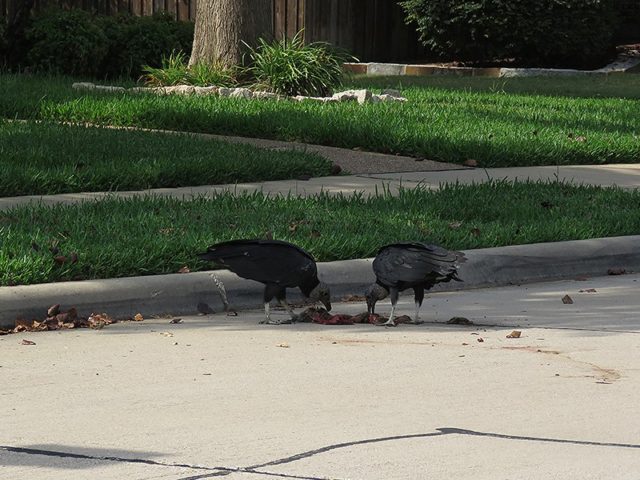
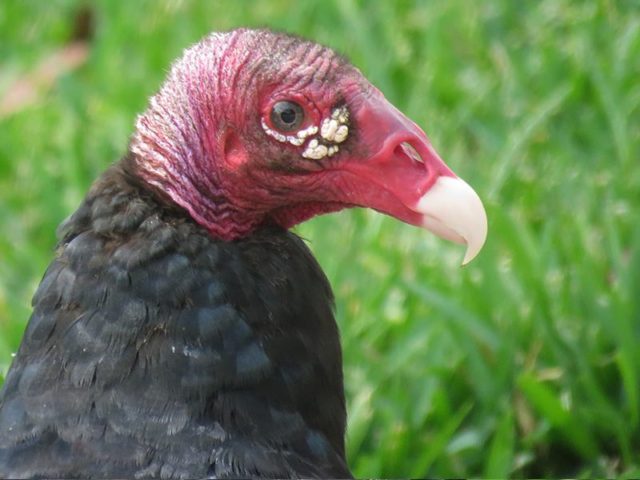
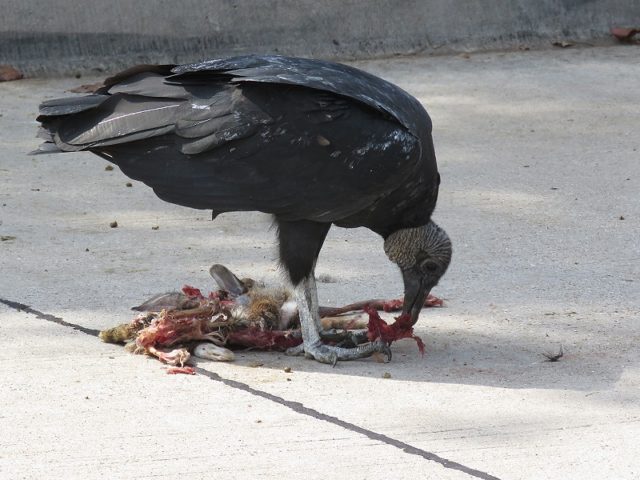
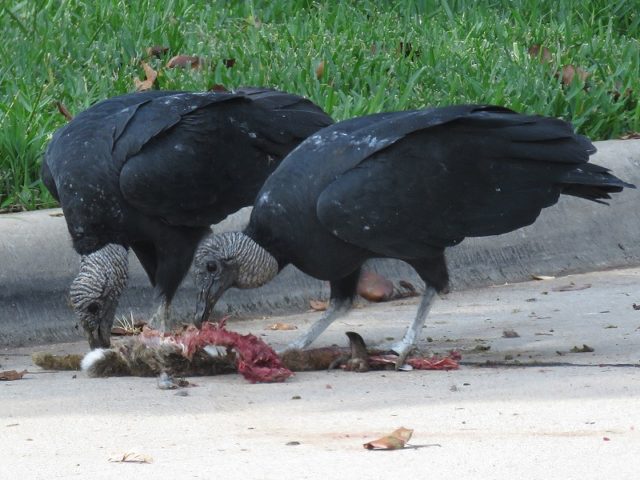



The turkey vulture feeds primarily on a wide variety of carrion, from small mammals to large grazers, preferring those recently dead, and avoiding carcasses that have reached the point of putrefaction. They may rarely feed on plant matter, shoreline vegetation, pumpkin, coconut and other crops, live insects and other invertebrates. In South America, turkey vultures have been photographed feeding on the fruits of the introduced oil palm. They rarely, if ever, kill prey themselves. The turkey vulture can often be seen along roadsides feeding on roadkill, or near bodies of water, feeding on washed-up fish. They also will feed on fish or insects that have become stranded in shallow water. Like other vultures, it plays an important role in the ecosystem by disposing of carrion, which would otherwise be a breeding ground for disease.
The turkey vulture forages by smell, an ability that is uncommon in the avian world, often flying low to the ground to pick up the scent of ethyl mercaptan, a gas produced by the beginnings of decay in dead animals. The olfactory lobe of its brain, responsible for processing smells, is particularly large compared to that of other animals. This heightened ability to detect odors allows it to search for carrion below the forest canopy. King vultures, black vultures, and condors, which lack the ability to smell carrion, follow the turkey vulture to carcasses. The turkey vulture arrives first at the carcass, or with greater yellow-headed vultures or lesser yellow-headed vultures, which also share the ability to smell carrion. It displaces the yellow-headed vultures from carcasses due to its larger size, but is displaced in turn by the king vulture and both types of condor, which make the first cut into the skin of the dead animal. This allows the smaller, weaker-billed turkey vulture access to food, because it cannot tear the tough hides of larger animals on its own. This is an example of mutual dependence between species.
